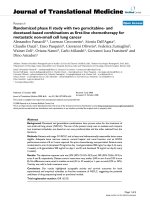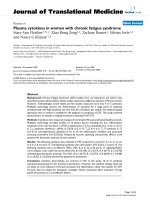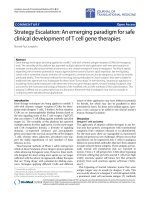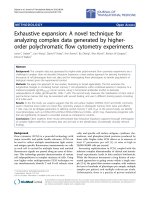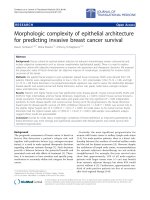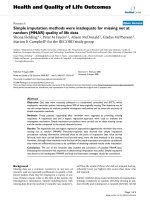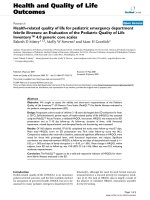Báo cáo hóa học: " Monodisperse Hollow Tricolor Pigment Particles for Electronic Paper" doc
Bạn đang xem bản rút gọn của tài liệu. Xem và tải ngay bản đầy đủ của tài liệu tại đây (483.37 KB, 6 trang )
NANO EXPRESS
Monodisperse Hollow Tricolor Pigment Particles
for Electronic Paper
Xianwei Meng
•
Fangqiong Tang
•
Bo Peng
•
Jun Ren
Received: 31 August 2009 / Accepted: 2 October 2009 / Published online: 25 October 2009
Ó to the authors 2009
Abstract A general approach has been designed to blue,
green, and red pigments by metal ions doping hollow TiO
2
.
The reaction involves initial formation of PS at TiO
2
core–
shell nanoparticles via a mixed-solvent method, and then
mixing with metal ions solution containing PEG, followed
calcining in the atmosphere. The as-prepared hollow pig-
ments exhibit uniform size, bright color, and tunable den-
sity, which are fit for electronic paper display.
Keywords E-paper Á Pigment Á Hollow Á Bistable
Introduction
In the past few years, electronic paper (E-paper), which is a
display technology based on the electrophoresis of charged
particles, has recently been enthusiastically investigated
with regard to not only their potential application in planar
display, but also the fundamental understanding of nano-
scopic phenomena [1–6]. There are many benefits over
other display technologies, such as low-power consump-
tion, good flexibility, low weight and high reflexivity and
contrast [7–10].
Ever since E-paper was first prepared, the performance
of electronic paper has been rapidly improved, as a result
of technological development and the accumulation of
fundamental knowledge. Despite tremendous advances,
one of the common challenges for all the electronic paper
techniques is to achieve full-color E-paper [11]. For col-
orization, color filters decrease the contrast and brightness.
A pixel composed of tricolor unites, in which red, blue, and
green particles are suspended in a fluid medium, respec-
tively, is a promising design. Thereby, it is necessary to
prepare tricolor pigment particles. For E-paper display, the
pigments should be bistable [12]. By applying the voltage,
the pigments move, while stopping the voltage, it will hold
still. The pigments will keep at the position until applying a
voltage. In the case, the matching of the pigments with the
dielectric medium is a key factor. There have been a few
early attempts at achieving the objectives. It involves
polymer coating on pigments or polymer–pigment hybrid
[13]; however, these pigments are limited as the polymer
decreases the color gamut. In this article, a solution for the
problem will be given while we prepare hollow pigments.
Here, a facile general method, which is based on the
tuning of the bandgap of semiconductor by metal ions
doping is developed to prepare monodisperse hollow tri-
color pigment particles. Titania and Cr
2?
metal ions are
selected as host materials and dopants, respectively. The
obtained green hollow pigment samples (Cr
3?
doped
TiO
2
), are well characterized by using X-ray diffraction
(XRD), scanning electron microscope (SEM), transmission
electron microscopy (TEM), and UV–vis diffuse reflection.
They show brilliant colors in visible region. And the den-
sity of hollow pigment particles is about 1.32 g/cm
3
, which
is very low and can match well with most of dispersants.
By the method, we can also prepare other metal ions doped
TiO
2
hollow nanocomposites, such as Co/Al doped TiO
2
hollow particles (blue), Fe doped TiO
2
hollow particles
(red). The monodisperse hollow tricolor pigment particles
are potential building blocks to fabricate full-color elec-
trophoretic display.
X. Meng Á F. Tang (&) Á B. Peng Á J. Ren
Laboratory of Controllable Preparation and Application of
Nanomaterials, Technical Institute of Physics and Chemistry,
Chinese Academy of Sciences, Beijing 100190,
People’s Republic of China
e-mail:
123
Nanoscale Res Lett (2010) 5:174–179
DOI 10.1007/s11671-009-9461-0
Experimental
Tetra-n-butyl titanate (TBT) and acetonitrile were pur-
chased from Sigma and used without further purification.
Potassium persulfate (KPS), FeCl
3
Á6H
2
O, CrCl
3
Á6H
2
O,
Al (NO
3
)
3
Á9H
2
O, Polyethylene glycol (PEG 10000),
styrene, ethanol, and ammonia were all supplied by the
Beijing Chemical Reagent Company. Styrene was purified
by distillation under reduced pressure. Ethanol was dehy-
drated by molecule sieves.
The monodisperse metal ions doped TiO
2
hollow par-
ticles were prepared by using the Pechini sol–gel process.
Anionic polystyrene (PS) spheres used as core materials
were prepared by emulsifier-free, emulsion polymerization
Fig. 1 The TEM and SEM
images pure PS particles (a), the
PS/TiO
2
hybrid particles (b) and
the TEM and SEM the
Cr
3?
-doped TiO
2
hollow
particles (c and d)
400 450 500 550 600 650 700 750 800
20
25
30
35
40
45
50
Reflectance (%)
Wavelength (nm)
400300200
0
10
20
Wavelength (nm)
Reflectance (%)
Fig. 2 The reflection spectrum
of monodisperse hollow
Cr
3?
-doped TiO
2
particles
Nanoscale Res Lett (2010) 5:174–179 175
123
using KPS as the anionic initiator. TiO
2
coating on the as-
prepared PS core was processed in the mixed solvent of
ethanol and acetonitrile by hydrolyzing TBT in the
presence of ammonia, as described in our previous report
[14]. 1.2 mmol CrCl
3
Á6H
2
O was first dissolved in a
water–ethanol (1/7 v/v) solution containing citric acid
which was two times as much as the metal ions in amount
of substance. And then a certain amount of the PEG
(10000) was added. The solution was stirred for 2 h and
then the above PS/TiO
2
hybrid spheres (0.04 g) were
added. After stirring for another 4 h, the particles were
separated by centrifugation. The samples were dried at
60 °C for 2 h and then annealed at 500 °C for 4 h with a
heating rate of 5 °C/min. Finally the preheated samples
were annealed at 600 °C for 2 h with a heating rate of
2 °C/min.
TEM (JEOL-200CX) and SEM (Hitachi 4300) were
used to observe the morphology of the particles. XRD
measurement was employed a Japan Regaku D/max cA
X-ray diffractometer equipped with graphite monochro-
matized Cu Ka radiation (k = 1.54 A
˚
) irradiated with a
scanning rate of 0.02 deg/s. Ultraviolet and visible
absorption (UV–vis) and diffuse reflectance spectra were
recorded at room temperature with the JASCO 570 spec-
trophotometer equipped with an integrated sphere.
Results and Discussion
E-paper is a straightforward fusion of chemistry, physics,
and electronics. The pigments are very important to the
E-paper properties [15–17]. In the interest of a full-color
electronic paper, the tricolor particles are required. For
green hollow nanospheres, PS at TiO
2
core–shell nano-
particles are synthesized by a mixed-solvent method, and
then mixed with Cr
3?
ions in the solution containing PEG,
followed calcined in the atmosphere. The monodisperse
Cr
3?
-doped TiO
2
hollow particles are prepared by using
the Pechini sol–gel process by varying the condition, such
as ratio of Cr
3?
ions to PS at TiO
2
and the concentration of
PEG. During the reaction, the chelate complexes of metal
ions react with PEG to form polyesters with suitable vis-
cosity, which coat on the surfaces of the PS/TiO
2
particles.
Figure 1 shows the TEM and SEM images of the
Cr
3?
-doped TiO
2
hollow particles. The morphology of the
pure PS particles (about 250 nm) (Fig. 1a) and the PS/TiO
2
hybrid particles (about 320 nm) (Fig. 1b) is presented. It
can be seen that a well-defined core–shell structure with PS
particle as core and TiO
2
as shell has been formed. The
inset in Fig. 1b shows the detailed structure. Typically,
Fig. 1c and d shows the TEM and SEM images of
Cr
3?
-doped TiO
2
hollow particles with uniform size and
shape. The size of all the hollow particles is about 300 nm
and shells are compact and the shells are uniform, intact,
and about 35 nm thick. From the inset in Fig. 1d, we can
find the hollow hemisphere is vivid.
The uniform hollow particle is an ideal candidate for
E-paper pigments. During the moving of pigment, the
electrophoretic velocity (m) is governed by the following
equation [18]:
m ¼ QE
=
4prg
where Q, r, g, and E represent the charge, particle radius,
viscosity of the suspension, and the potential difference
applied to the suspension, respectively. The suspension
viscosity can be considered constant in suspension. Under
this condition, the electrophoretic velocity is mainly a
function of the electric field and the particle size. As the
particles in the suspension used for E-paper usually have
a distribution of particle sizes, particles with different
r value have different electrophoretic mobility, thereby
resulting in the segregation effects observed during the
display process. From the equation, we know that the
particles with the same size shuttle between the up and
down side of a pixel simultaneously. Thus, the uniform
Cr
3?
-doped TiO
2
hollow particles will improve display
properties.
As shown in Fig. 2, the reflection spectra of the hollow
particles are measured. It can be seen that the peak
for Cr
3?
-doped TiO
2
hollow particles in the visible region
(204)
(105)
(211)
(200)
(004)
(101)
(211)
(111)
(101)
(110)
b
a
a: Cr doped TiO
2
b: TiO
2
20 25 30 35 40 45 50 55
60
65
70 75 80
intensity (a.u.)
2θ
Fig. 3 XRD profile of Cr
3?
doped (a) and TiO
2
hollow particles (b).
And the EDX spectra of the Cr
3?
-doped TiO
2
hollow particles
176 Nanoscale Res Lett (2010) 5:174–179
123
are 570 nm. And the reflection edges of most samples are
somewhat steep, indicating brilliant colors of the hollow
particles. The suspension of the hollow particles in ethyl-
ene glycol shows yellow green, shown in the inset in
Fig. 2b, which implies that Cr
3?
-doped TiO
2
hollow par-
ticles could be used as excellent pigments. And the
reflectance in ultraviolet B range is very low, between 4.9
and 8.7% (Fig. 2b).
To verify the compositions of the obtained multifunc-
tional hollow nanocomposites, the energy-dispersive X-ray
(EDX) spectrums of Cr
3?
-doped TiO
2
hollow particles is
recorded (Fig. 3). And O, Ti, Cr, and Si peaks for doped
TiO
2
are observed (silicon signal from the silicon
substrate). These results indicate that the hollow Cr
3?
-
doped TiO
2
nanocomposites are synthesized successfully.
Figure 3b shows the typical XRD patterns of Cr
3?
-doped
TiO
2
hollow particles and TiO
2
hollow particles. All of the
detectable peaks of Cr
3?
-doped TiO
2
can be indexed as the
TiO
2
with rutile structure (Fig. 3a). And the peaks corre-
sponding to 27.38, 35.98, 41.18, and 54.18 are in good
agreement with (110), (101), (111), and (211) planes of
the rutile (rutile phases JCPDS 77-0443). But The XRD
patterns of TiO
2
hollow particles without any dopants
obtained under the same conditions consists of anatase
(Fig. 3b). And the peaks corresponding to 25.38, 37.88,488
53.98,558, and 62.78 can be assigned to (101), (004), (200),
(105), (211), and (204) planes of the rutile (rutile phases
JCPDS 77-0443). This indicates that the substitution metal
ions for Ti have promoted the A-R phase transition.
Thereby, the hollow particles do not only show brilliant
colors, but also high stability in ultraviolet and visible
region.
When Fe
3?
,Co
2?
, and Al
3?
ions are used as the starting
materials, red (Fig. 4) and blue (Fig. 5) metal-doped
Fig. 4 The TEM and SEM
images, and the reflection
spectrum of Fe
3?
-doped red
hollow particles
Nanoscale Res Lett (2010) 5:174–179 177
123
hollow particles are synthesized. The inorganic pigments
can be used as full-color E-paper display.
Conclusions
The monodisperse Cr
3?
-doped TiO
2
hollow particles are
prepared by using the Pechini sol–gel process, in which PS
at TiO
2
core–shell nanoparticles are synthesized by a
mixed-solvent method, and then mixed with Cr
3?
in the
solution containing PEG, followed calcined in the atmo-
sphere. Fe
3?
-doped TiO
2
(red) and Co
2?
/Al
3?
-doped TiO
2
(blue) hollow nanocomposites are also prepared by this
method. The hollow pigments are good candidates for full-
color E-paper display.
Acknowledgment The financial support for this research was pro-
vided by the Hi-Tech Research and Development Program of China
(863) (2009AA03Z322), and the National Natural Science Foundation
of China (60736001).
References
1. B. Comiskey, J.D. Albert, Y. Hidekazu, Nature 394, 253 (1998)
2. G.R. Jo, K. Hoshino, T. Kitamura, Chem. Mater. 14, 664 (2002)
3. R.A. Hayes, B.J. Feenstra, Nature 425, 383 (2003)
4. J.P. Wang, X.P. Zhao, H.L. Guo, Optical Mater. 30, 1268 (2008)
5. T. Bot, H. De Smet, F. Beunis, K. Neyts, Displays 27, 50 (2006)
6. A.C. Arsenault, D.P. Puzzo, I. Manners, G.A. Ozin, Nat. Photon.
1, 468 (2007)
7. J.Y. Lee, J.H. Sung, I.B. Jang, Synth. Met. 153, 221 (2005)
8. Y.T. Wang, X.P. Zhao, D.W. Wang, J. Microencapsu1e 23, 762
(2006)
9. C.A. Kim, M.J. Joung, S.D. Ahn, Synth. Met. 151, 181 (2005)
10. T. Bot, H. De Smet, Displays 24, 223 (2003)
11. D.P. Puzzo, A.C. Arsenault, I. Manners, G.A. Ozin, Angew.
Chem. Int. Ed. 47, 1 (2008)
12. T. Bot, H. De Smet, Displays 24, 103 (2003)
200nm 200nm
350 400 450 500 550 600 650 700 750 800 850
20
25
30
35
40
45
50
55
60
65
70
75
80
Co
2+
/Al
3+
dopedTiO
2
Reflectance
Wavelength (nm)
Fig. 5 The TEM and SEM
images, and the reflection
spectrum of and Co
2?
/Al
3?
-
doped blue hollow particles
178 Nanoscale Res Lett (2010) 5:174–179
123
13. D.G. Yu, J.H. An, J.Y. Bae, S.D. Ahn, S.Y. Kang, K.S. Suh,
Macromolecules 38, 7485 (2005)
14. P. Wang, D. Chen, F.Q. Tang, Langmuir 22, 4832 (2006)
15. H.S. Kang, H.J. Cha, J.C. Kim, Mol. Cryst. Liq. Cryst. 472, 247
(2007)
16. I.B. Jang, J.H. Sung, H.J. Choi, Synth. Met. 152, 9 (2005)
17. B. Peng, F.Q. Tang, D. Chen, X.L. Ren, X.W. Meng, J. Ren,
J. Colloid Interf. Sci. 329, 62 (2009)
18. X.W. Meng, T.Y. Kwon, Y.Z. Yang, J.L. Ong, K.H. Kim,
J. Biomed. Mater. Res. B 78B, 373 (2006)
Nanoscale Res Lett (2010) 5:174–179 179
123
